
Mating and Molting!
Deer ticks live on average for two years and have three blood meals. Within these two years, ticks exhibit a four stage life cycle—adult, egg, larva, and nymph. The life cycle begins when the female lays the eggs. As the egg matures, they develop into larvae then into nymph and finally become an adult.
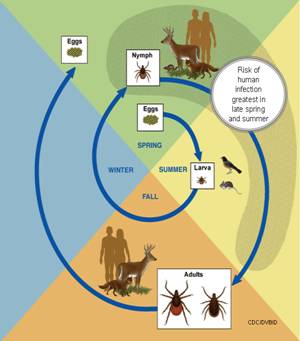
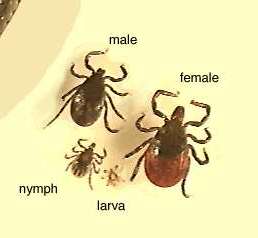
Mating can take place on or off the host. Many times mating
occurs right before or immediately
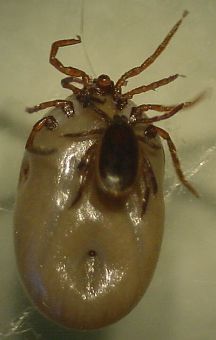 after
the female's feeding session. The mating ritual is initiated
by the female secreting its pheromones to lure the male. Once the
male has located the female by following the pheromones it will
mount the female. The male then proceeds to investigate the
female in hopes to find her gonopore. Then with his mouthparts he
probes the genital pore. If he is compatible he will receive the
appropriate chemical stimuli response which initiates spermatophore
formation. After about 10-15 minutes the spermatophore
formation is complete and is filled with a mass of proteinaceous
material, which includes the spermine. The spermatophore is then
ejected from the male’s genital pore. The male removes its mouthparts
from the female and with his chelicerae he removes the spermatophore
that was ejected and places it into the female’s vestibular vagina.
The CO2 formed within the spermatophore creates the necessary
pressure to force the mass of sperm, seminal fluid and symbionts
into the seminal receptacle. Then the sperm, inside the female’s
genital tract passes into the oviducts and ovary where fertilization
can occur.
after
the female's feeding session. The mating ritual is initiated
by the female secreting its pheromones to lure the male. Once the
male has located the female by following the pheromones it will
mount the female. The male then proceeds to investigate the
female in hopes to find her gonopore. Then with his mouthparts he
probes the genital pore. If he is compatible he will receive the
appropriate chemical stimuli response which initiates spermatophore
formation. After about 10-15 minutes the spermatophore
formation is complete and is filled with a mass of proteinaceous
material, which includes the spermine. The spermatophore is then
ejected from the male’s genital pore. The male removes its mouthparts
from the female and with his chelicerae he removes the spermatophore
that was ejected and places it into the female’s vestibular vagina.
The CO2 formed within the spermatophore creates the necessary
pressure to force the mass of sperm, seminal fluid and symbionts
into the seminal receptacle. Then the sperm, inside the female’s
genital tract passes into the oviducts and ovary where fertilization
can occur.
Fully fed, mated females drop from the host and find a sheltered
environment to lay their eggs.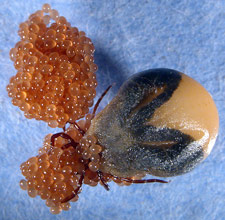 The amount of eggs laid is influenced by the size of their blood
meal. If the female consumed a larger amount of blood it may lay a
greater amount of eggs compared to a female who had a much smaller
blood meal. The amount of eggs can range anywhere from
hundreds to thousands of eggs in a single gonotrophic cycle.
Ovipositioin beings within three to six days after feeding when the
temperature is around 27°C. Egg production increases rapidly,
reaching its peak around the fourth day. Egg production continues
for 16-17 days with an overall time frame of 20-21 days for egg
laying. The majority of the eggs are laid by the tenth day.
The female is known to remain in one position for the entirety and
the eggs will accumulate in a great mass in from and sometimes over
the anterior part of the female’s body. Once their eggs are
laid the female dies. However, the males live to mate several
different females. The hatching period is usually sometime between
May and September.
The amount of eggs laid is influenced by the size of their blood
meal. If the female consumed a larger amount of blood it may lay a
greater amount of eggs compared to a female who had a much smaller
blood meal. The amount of eggs can range anywhere from
hundreds to thousands of eggs in a single gonotrophic cycle.
Ovipositioin beings within three to six days after feeding when the
temperature is around 27°C. Egg production increases rapidly,
reaching its peak around the fourth day. Egg production continues
for 16-17 days with an overall time frame of 20-21 days for egg
laying. The majority of the eggs are laid by the tenth day.
The female is known to remain in one position for the entirety and
the eggs will accumulate in a great mass in from and sometimes over
the anterior part of the female’s body. Once their eggs are
laid the female dies. However, the males live to mate several
different females. The hatching period is usually sometime between
May and September.
From the eggs come tiny 6-legged larvae about the size of the
period at the end of this sentence. The larva continue their life
cycle by finding a host. Once a suitable host has been chosen
it
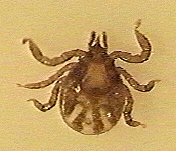 attaches
and feds until full. When full, it detaches itself and drops to the
ground to find a sheltered habitat, an environment such as sand,
soil, leaf litter, or in cracks crevices, or sometimes fibers of
their hosts habitat. After a few days, the larva will metamorphose
into the next state of its life cycle via a process called molting;
in this case the larva molts into the nymph.
Molting can be a very slow process. Temperature and feeding success
can greatly influence the time it takes to complete the molting
process. Molting can only take place under temperatures above 18°C.
If the temperature falls below that, the molting process will be
delayed. Similar to the effect of feeding success on egg
production, the smaller the blood meal the smaller the nymph and the
larger the blood meal the larger the nymph. The nymph becomes
dormant until the following spring.
attaches
and feds until full. When full, it detaches itself and drops to the
ground to find a sheltered habitat, an environment such as sand,
soil, leaf litter, or in cracks crevices, or sometimes fibers of
their hosts habitat. After a few days, the larva will metamorphose
into the next state of its life cycle via a process called molting;
in this case the larva molts into the nymph.
Molting can be a very slow process. Temperature and feeding success
can greatly influence the time it takes to complete the molting
process. Molting can only take place under temperatures above 18°C.
If the temperature falls below that, the molting process will be
delayed. Similar to the effect of feeding success on egg
production, the smaller the blood meal the smaller the nymph and the
larger the blood meal the larger the nymph. The nymph becomes
dormant until the following spring.
A nymph, approximately the size of a poppy seed, has 8 legs but still does not develop sex organs. In the spring and summer of the ticks second year, usually between May and June the nymph becomes active and beings its search for a suitable host to fulfill its second feeding. Once the nymph has finished the feeding period and has released itself from the host they again find a sheltered habitat to begin the molting process. Some nymphs feed several times and molt to another nymph form before feeding and molting to an adults, while others feed only once and molt to an adult.
The adult tick breaks out of the nymphal skin and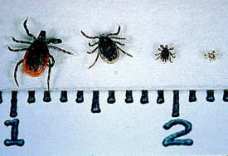 like the larva
and nymph quests to find a suitable host. Adult activity
typically begins in October and ends mid-December with
its peak activity in November. There has been some evidence
dictating another activity peak found in spring between April and
June. If the adult tick does not find a host in fall, they go
dormant through the winter months and then continue to quest the
following fall. Once the female adult has fed, mated, and laid eggs
it dies whereas the male adult continues to mate with numerous
females before its death.
like the larva
and nymph quests to find a suitable host. Adult activity
typically begins in October and ends mid-December with
its peak activity in November. There has been some evidence
dictating another activity peak found in spring between April and
June. If the adult tick does not find a host in fall, they go
dormant through the winter months and then continue to quest the
following fall. Once the female adult has fed, mated, and laid eggs
it dies whereas the male adult continues to mate with numerous
females before its death.
 |
Activity
patterns: Adult: October – Mid-December Peak activity: November Nymph: (unimodal) May through early July Peak activity: June Larval: (unimodal) May through Semptember Peak Activity: August |
To find out who and how I interact with you or those around you click here
To
Main Page